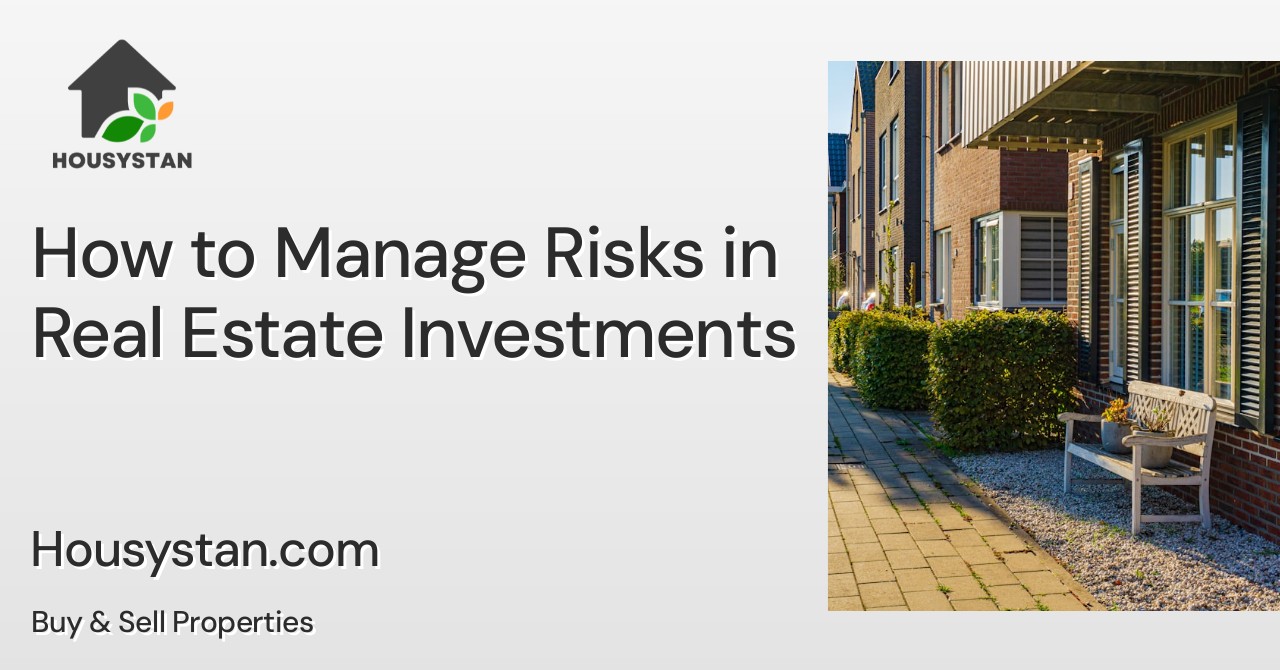How to Manage Risks in Real Estate Investments
Read latest blogs and articles from Housystan

The Information mentioned here was last updated on:
18/12/2025Managing Risks in Real Estate Investments
Real estate is often seen as a stable and lucrative investment, but like any other investment, it comes with its own set of risks. Understanding how to manage these risks can help investors make informed decisions and protect their investments over the long term. This guide will dive into various strategies and considerations to effectively manage risks in real estate investments.
Understanding Real Estate Investment Risks
- Verified Tenants/Buyers
- Unlimited Property Listing
- Zero subscription/charges fee
Investing in real estate involves various types of risks, and being aware of them is the first step in mitigating them effectively. Key risks include:
- Market Risk: The potential loss due to changes in market conditions, such as economic downturns or changes in property demand.
- Financial Risk: Relating to fluctuations in interest rates, loan defaults, or changes in financing terms.
- Property-Specific Risk: Involving property location, condition, and unexpected maintenance costs.
- Legal and Regulatory Risk: New laws and regulations that can affect property investments, such as zoning changes or property taxes.
Market Risk Management
Market risk refers to the uncertainty of future market conditions that can negatively impact property value or rental income. Here’s how to manage it:
- Diversification: Diversify your investment portfolio by investing in different types of properties (residential, commercial, industrial) and in various geographic locations. This reduces dependency on a single market segment.
- Research and Analysis: Conduct thorough market research to understand trends, growth prospects, and potential downturns. Utilize resources like local real estate reports, economic forecasts, and demographic data.
- Stay Informed: Keep up-to-date with news and trends that could impact the real estate market, such as changes in interest rates, employment rates, and migration patterns.
Financial Risk Management
Financial risk is often associated with how real estate is financed. To manage financial risk:
- Leverage Wisely: Use leverage cautiously. High leverage increases exposure to financial risk, especially if interest rates rise or property values decrease.
- Fixed-Rate Mortgages: Consider opting for fixed-rate mortgages to protect against interest rate volatility. This ensures predictable mortgage payments over the loan term.
- Emergency Fund: Maintain a reserve fund to cover unexpected expenses or mortgage payments during periods of low occupancy or emergency repairs.
Property-Specific Risk Management
Property-specific risks are unique to the property itself, related to its physical condition and location.
- Inspection and Maintenance: Conduct regular property inspections and maintenance to prevent small issues from becoming costly repairs. Schedule annual checks for plumbing, electrical systems, and structural integrity.
- Insurance Coverage: Protect your investment with comprehensive insurance that covers major risks like fire, floods, and liability. Review your coverage regularly and adjust it as necessary.
- Location and Demographics: Evaluate the property’s location, considering factors like proximity to schools, transportation, and economic centers. Properties in growing areas typically present lower risk.
Legal and Regulatory Risk Management
Understanding and complying with legal and regulatory requirements is essential in managing risks:
- Stay Compliant: Familiarize yourself with local zoning laws, building codes, and property regulations. Consistently review legal obligations to avoid fines or penalties.
- Hire Professionals: Consult with legal and tax professionals who specialize in real estate to ensure compliance and receive expert advice on managing legal risks.
- Proactive Adjustment: Monitor regulatory changes that might affect your investment strategy, such as new rent control measures or property tax hikes.
Additional Strategies for Risk Management
Beyond addressing specific types of risks, there are additional strategies that can help reinforce risk management efforts:
- Invest in Technology: Use property management software to track expenses, rents, and maintenance schedules efficiently. This ensures you remain organized and responsive to property needs.
- Tenant Screening: Implement strict tenant screening processes to minimize the risk of default or damage. Look for creditworthy tenants with stable employment history.
- Exit Strategy: Have a clear exit strategy for each investment. This involves knowing when to sell, based on market trends or changes in personal financial goals.
Continuous Learning and Networking
A successful real estate investor is always learning and growing their network. Here are ways to keep learning:
- Education: Attend workshops, seminars, and real estate courses to enhance your knowledge and stay current on industry trends.
- Networking: Join real estate investment groups and forums to connect with other investors. Networking can offer insights into new opportunities and potential risks.
- Professional Advice: Leverage the experience and knowledge of real estate agents, brokers, and other investment professionals for insight and advice.
By adopting these comprehensive strategies, real estate investors can safeguard their investments and position themselves for long-term success. Effective risk management is not just about minimizing downsides but also about being prepared to capitalize on opportunities as they arise in the ever-changing real estate market. Investing in a combination of education, diversification, and professional guidance will empower investors to navigate the complexities of real estate with confidence.